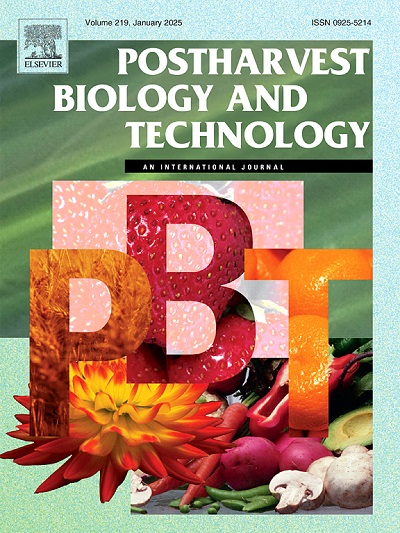Effects of exogenous gibberellic acid on chlorophyll metabolism of Sudachi (Citrus sudachi Hort.) after harvest
IF 6.4
1区 农林科学
Q1 AGRONOMY
引用次数: 0
Abstract
Sudachi (Citrus sudachi Hort.), cultivated in Japan, is a type of sour citrus fruit. Sudachi fruit is preferred by consumers for its rich flavor during the green period of the peel. As the Sudachi fruit ripens, the flavedo color changes from green to yellow and the fruit loses its flavor. In the present study, to inhibit the color development in the flavedo of Sudachi, the fruit were dipped in 500 μM of gibberellic acid (GA) solution for 1 h, and the effects on chlorophyll metabolism were investigated in Sudachi fruit. The results indicated that the GA treatment delayed the degreening, and inhibited the decrease in chlorophyll contents in the flavedo of Sudachi. With GA treatment, the expression levels of chlorophyll biosynthetic genes (CitGUN4, CitCHLH, CitPORA, CitCHL27, and CitGGDR) were upregulated and chlorophyll catabolic genes (CitNYC, CitPPH, CitSGR, and CitPAO) were downregulated, which led to preserving a high levels of chlorophyll contents. The results of this study elucidated the molecular mechanism of the GA effect on citrus fruit, which suggested that GA effectively inhibited the yellowing of citrus flavedo.
求助全文
约1分钟内获得全文
求助全文
来源期刊

Postharvest Biology and Technology
农林科学-农艺学
CiteScore
12.00
自引率
11.40%
发文量
309
审稿时长
38 days
期刊介绍:
The journal is devoted exclusively to the publication of original papers, review articles and frontiers articles on biological and technological postharvest research. This includes the areas of postharvest storage, treatments and underpinning mechanisms, quality evaluation, packaging, handling and distribution of fresh horticultural crops including fruit, vegetables, flowers and nuts, but excluding grains, seeds and forages.
Papers reporting novel insights from fundamental and interdisciplinary research will be particularly encouraged. These disciplines include systems biology, bioinformatics, entomology, plant physiology, plant pathology, (bio)chemistry, engineering, modelling, and technologies for nondestructive testing.
Manuscripts on fresh food crops that will be further processed after postharvest storage, or on food processes beyond refrigeration, packaging and minimal processing will not be considered.
 求助内容:
求助内容: 应助结果提醒方式:
应助结果提醒方式:


